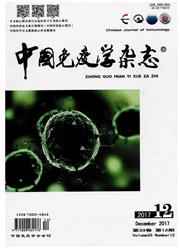

 中文摘要:
中文摘要:
目的:构建人E1A激活基因阻遏子(Human cellular repressor of E1A-stimulated gene,hCREG)基因的真核表达载体并转染人293F细胞株,筛选稳定转染细胞克隆,鉴定重组的分泌型hCREG/myc.His融合蛋白的糖基修饰和生物学功能。方法:用RT-PCR技术扩增终止密码突变的hCREG开放读码框并构建pcDNA4myc.His/hCREG真核表达载体;Lipofeetamine2000转染人293F细胞株并筛选稳定表达细胞克隆,去血清法诱导重组蛋白表达;应用Westernblot方法鉴定分泌型hCREG/myc-His融合蛋白的表达,糖苷酶法及Westernblot行hCREG/myc-His融合蛋白的糖基化分析;用流式细胞周期分析分泌型hCREG/myc.His融合蛋白对体外培养的人胸廓内动脉平滑肌细胞(HITASY)增殖能力的影响。结果:RT-PCR扩增含终止密码突变的hCREGeDNA片段,经BamHⅠ和EcoRⅠ双酶切构建了pcDNA4myc.His/hCREG真核表达载体,酶切及测序结果证实构建的重组质粒正确;Westernblot证实转染pcDNA4myc.His/hCREG的293F细胞克隆可以稳定表达并分泌hCREG/myc-His融合蛋白;糖苷酶分析证实分泌型hCREG/myc-His融合蛋白是糖基化蛋白;流式细胞周期分析证实与正常培养HITASY细胞比较,添加含有分泌型hCREG/myc-His糖蛋白上清的H1TASY细胞出现明显的G1期细胞周期阻滞现象(58.88%vs62.89%,P〈0.005)。结论:构建了pcDNA4myc-His/hCREG真核表达载体并表达了具有生物学功能的分泌型重组hCREG/myc-His糖蛋白。
 英文摘要:
英文摘要:
Objective:To construct the eukaryotic expressing vector of human cellular repressor of E1A-stimulated gene (hCPEG) and then analyze it expression and bio-activities after transfected into human 293F cells.Methods: The fragments of hCREG ORF with terminator cedon mutation were amplificated by RT-PCR and the eukaryotic expressing vector-pcDNA4 myc-His/hCREG was constructed. The human 293F cells were transfected with Lipofectamine 2 000 and stably transfected cell clones were screened. The expression of secreted recombinant hCREG/myc-His protein was induced by senan withdrawal and identified by Western blot. The secreted glycoprotein was detected with PNGaseF digestion and Western blot. The effect of secreted hCREG/myc-His protein on proliferation of human intra-thoracic artery smooth muscle cells (HITASY) was evaluated by Flow cytometry analysis.Results: The cDNA fragments of hCREG ORF with terminator cedon mutation was obtained by amplification with RT-PCR and the pcDNA4 myc-His/hCREG eukaryotic expressing vector was constructed by EcoRI/BamHI digestion. The recombinant eukaryotic expressing vector was confirmed correct by restricted endonuclease digestion and DNA sequencing, The transfected 293F cell clones expressed stably secretory hCREG/myc-His fusion protein in Western blot. The secreted protein of hCREG/myc- His was confirmed to be glycosylated by PNGaseF digestion. Futhermore, more HITASY cells were obviously arrested in G1 phase compared with the control when cultured in supematant with the secreted glycoprotein by Flow cytometry analysis( 58.88 % vs 62.89 %, P 〈 0. 005). Conclusion: The eukaryotic expressing vector pcDNA4 myc-His/hCREG is constructed successfully and the secreted glycopmtoin of hCREG/myc-His is expressed with biological activity.
 同期刊论文项目
同期刊论文项目
 同项目期刊论文
同项目期刊论文
 Secreted CREG inhibits cell proliferation mediated by mannose 6-phosphate/ insulin-like growth facto
Secreted CREG inhibits cell proliferation mediated by mannose 6-phosphate/ insulin-like growth facto 期刊信息
期刊信息
